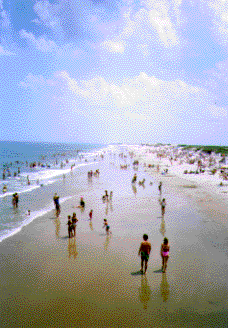 The natural character of sandy beaches is to change shape constantly and to move landward (retreat) or seaward
(advance). The changes are caused by changes in the forces that move the sand, namely wind, waves, and currents,
and by the supply of sand. Short- and long-term relative sea-level changes also control shoreline movement.
The natural character of sandy beaches is to change shape constantly and to move landward (retreat) or seaward
(advance). The changes are caused by changes in the forces that move the sand, namely wind, waves, and currents,
and by the supply of sand. Short- and long-term relative sea-level changes also control shoreline movement. The setting of the shoreline and the supply of sand determine how the shoreline changes at a particular location. Setting refers to whether a beach is sheltered from waves, adjacent to a tidal or storm channel, or next to a jetty or seawall, to state a few examples.
To understand and predict the rate of change, we need to distinguish between long-term, short-term, and episodic changes and to understand their causes. Long-term change occurs over tens to thousands of years, short-term change refers to movement occurring over several seasons to 5 or 10 years, and episodic change is that which occurs in response to a single storm.
Long-Term Change
We basically understand that it is the changing of sea level relative to the land and the increase and decrease in sand supply to the coast that cause the shoreline to retreat or advance over a period of about 50 years or more. The long-term rise in relative sea level along the upper Texas coast has moved the shoreline by simply inundating it and by shifting the action of waves and currents landward. Relative sea-level rise has also limited sand supply to the coast by drowning ancient river valleys and forming the coastal bays, such as Galveston and Matagorda Bays. Rivers that used to supply sand to the beaches now dump their sand at the heads of these bays where it is kept from reaching the open coast.
The natural geologic setting has not much sand left offshore to resupply eroding beaches either. Generally the sand turns to mud less than about 4 km offshore (White et al., 1988, 1989). Thus the natural geological setting of the upper Texas coast has created a shoreline that is low in sand supply and that is undergoing long-term relative sea-level rise. For these reasons, the shoreline will continue to undergo long-term retreat unless human intervention prevails.
Short-Term Change
Shoreline change that occurs over a few tens of years or less and that may be in the opposite direction of the long-term trend is difficult to understand and predict. These short-term shoreline changes can also be quite variable alongshore. One portion of the coast may be experiencing retreat while just a few kilometers away stable or advancing conditions may prevail. A shoreline that has retreated over the last 100 years may have experienced periods of shoreline advance, and this is the case for various periods and locations along Matagorda Peninsula since the 1930's.
It is important, however, for coastal residents to understand that even though a particular beach may have been advancing or stable over the last several years, if it has been retreating for the previous decades, then retreat will eventually resume. An exception to this rule would be if something fundamental, such as a "permanent" increase or decrease in the sand supply, has changed in the system.
Episodic Shoreline Retreat
Shoreline retreat is not always a continuous and steady process with a little more of the beach eroded each year. Tropical storms and hurricanes along the upper Texas coast can move the shoreline more than 30 m landward in a day. There is often dramatic recovery for months and years following a storm, but it is usually incomplete, and the shoreline remains significantly landward of its prestorm position.
Even though shoreline change rates are given as annual rates, they must be considered "average" annual rates. A particular shoreline with a long-term retreat rate of 2 m/yr would be expected to be 120 m landward in 60 years. A single storm, however, could cause much of this movement.
This summary is taken from the Bureau of Economic Geology's report on the Gulf of Mexico Shoreline Change from the Brazos River to Pass Cavallo.